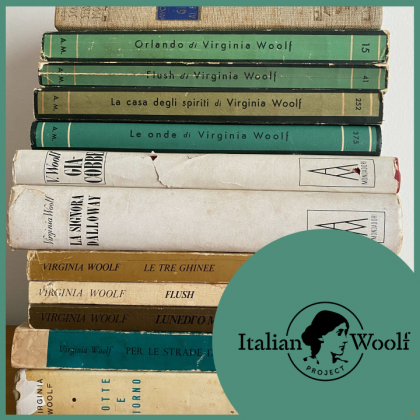[Clicca qui per leggere in Italiano]
Don’t judge a book by its cover. Well, actually, DO!
As all scholars of book culture and book materiality know, the cover of a book tells a lot about how publishers intend to place that work on the marketplace and it also tells about its expected readers. Observing the evolution of a writer’s covers might also be quite revealing of the work of cultural mediation done by publishers and editors to present and sell that writer on a foreign marketplace.
Since social networks are among the means that the EU suggests to communicate the results of European Grants’ research; since in these weeks I was supposed to be travelling around Italian archives while, unfortunately, I’m locked in my house because of the Covid-19 emergency; and since one of the goals of my research is to document all the Italian editions of Virginia Woolf’s works, I’ve opened an Instagram profile called ItalianWoolf_project where, by and by, I will upload all Italian editions of Woolf’s works in chronological order.
In the description of each post, Instagram users will also find physical details, such as the presence of paratexts or illustrations, and where possible I will add some anecdotes on the translation or publication process. The aim is to obtain a profile displaying the evolution of Woolf’s Italian covers to show, and understand, how the appearance of Woolf’s work on the Italian marketplace changed across time and in which way this connects to her reception. The idea is also to engage Italian readers to share photos of their own editions of Woolf’s works, in order to map out all the re-editions and re-translations appeared on the Italian marketplace.
You can find the project here: https://www.instagram.com/italianwoolf_project/

Non si giudica un libro dalla copertina. Be’, in realtà sì!
Come tutti gli studiosi di storia dell’editoria e storia del libro sanno, la copertina di un libro dice moltissime di come gli editori intendono collocare quel lavoro sul mercato e sui suoi lettori potenziali. Osservare l’evoluzione delle copertine di uno scrittore o di una scrittrice può rivelare moltissimo sul lavoro di mediazione culturale svolto da editori e curatori per presentare e vendere quello scrittore o quella scrittrice a un mercato straniero.
Poiché i social networks sono tra i mezzi suggeriti dall’UE per comunicare i risultati della ricerca dei Grant europei; poiché in queste settimane dovrei essere in giro per l’Italia a fare ricerca negli archivi e invece sono chiusa in casa a causa dell’emergenza Covid-19; e poiché tra gli scopi della mia ricerca c’è quello di documentare tutte le edizioni italiane dei lavori di Virginia Woolf, ho aperto un profilo Instagram chiamato ItalianWoolf_project dove man mano caricherò tutte le edizioni italiane delle opere di Woolf in ordine cronologico.
Nella descrizione di ogni post gli utenti troveranno anche alcuni dettagli fisici, come la presenza di paratesti o illustrazioni, e dove possibile aggiungerò qualche aneddoto sui processi di traduzione ed edizione. Lo scopo è ottenere un profile che mostri l’evoluzione delle copertine italiane di Woolf per comprendere come l’apparenza delle opere di Woolf sul mercato italiano cambiò nel corso degli anni e in che modo questo abbia a che fare con la sua ricezione. L’idea è anche quella di coinvolgere i lettori italiani a condividere foto delle edizioni delle opere di Woolf in loro possesso, per mappare tutte le riedizioni e ritraduzioni che sono apparse sul mercato italiano.
Potete trovare il progetto qui: https://www.instagram.com/italianwoolf_project/

